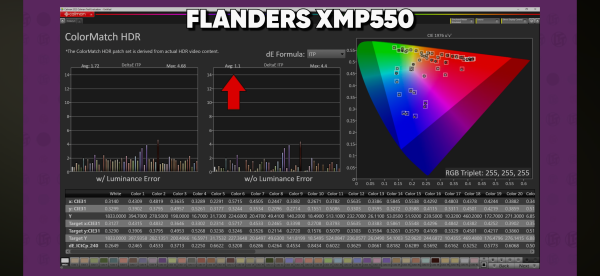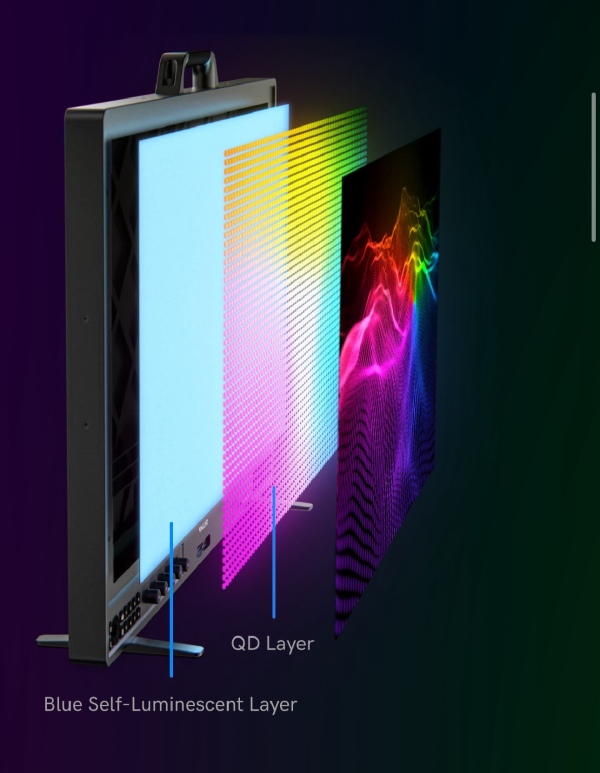The Flanders XMP550 QD-OLED reference mastering monitor vs. the Sony Bravia XR A95L on Calman’s rigorous ColorMatch test, which measures the performance of the display with samples extracted from true HDR content. Both displays use panels from Samsung Display. The Flanders was measured by Linus Tech and the Sony measurements are from Digital Day. Pretty... Continue Reading →
First Look: SmallHD Quantum 32 monitor
Quantum 32 is the result of a partnership between SmallHD and Samsung Display Corporation to create an HDR reference monitor that meets the requirements of motion picture production and post. SDC has pioneered quantum dot OLED, utilizing Nobel Prize-winning nanotechnology to achieve unparalleled color and dynamic range.
Canadian Media Engineer Confirms That LG Has Not Rolled Out FW Update To Disable G3 Auto-Dimming Beyond USA
“Hi, my names Rich and I'm a media engineer for Animal Logic in Vancouver, Canada. One of our DI colorists told me about your website and forums [liftgammagain], so I thought I'd share what we've been doing in order to try and turn off the fabled dimming on the LG G3. We got a Canadian... Continue Reading →
Flanders Scientific Announces 32” QD-OLED Reference Monitor
The XMP310 is a 31.5" UHD resolution HDR and SDR reference monitor built around the same industry leading QD-OLED panel technology as our HPA Award Winning 55" XMP550. With 1,000nits peak luminance, 1.5Million:1 contrast, and an exceptionally wide color gamut the XMP310 is ready to handle your most demanding HDR and SDR monitoring needs. The... Continue Reading →
MicroLED Industry Association White Paper: Mass Production Still Years Away
The MicroLED Industry Association (MIA) has published MicroLEDs 2023: State of the industry and future roadmap, a non-member summary of the full document, which paints a bleak picture for those of us who were hoping to snatch a 77” microLED TV before being dispatched to an assisted living residence. MicroLED Market and Industry Landscape Mass... Continue Reading →
Pick Up The Sony A95L QD-OLED With No ASBL!
Update 18.04.2024: “Sony can provide custom firmware to Hollywood studios to disable panel ABL (dimming) [on the consumer A95L] but it will void warranty.” Sony must have been referring to ASBL, not ABL. Source: FlatpanelsHD When Sony announced the release of the FWD-A95L sometime earlier this month, we reached out to Sony Professional and B&H... Continue Reading →
Calibrate The Sony A95L TV With Calman
https://youtu.be/oYVy_P2_R7o?si=tXr_lrgNmodcUGTi In his review of the Sony A95L, Paolo Centofanti wrote: “Usually, the software calibrates on the native panel range of 2.2, while with a special LUT invisible to the user, the TV adapts the parameters for other gamma values and the different curves of the various HDR modes. The problem we have encountered is that... Continue Reading →
Do QD-OLEDs Use Color Filters?
Samsung Display's marketing materials imply that no color filters are used in their QD-OLED displays, which is not 100% true. High color gamut requires very low blue light leakage. As can be seen in the illustrations, without any color filters at all, blue light leakage will occur in the red and green channels, impacting gamut... Continue Reading →
Flanders Scientific Introduces The XMP650, A 65″ UHD/HDR And SDR Reference Mastering Monitor
Featuring 2,000nits peak luminance, 4,000,000:1 contrast, and our widest color gamut to date, the XMP650 qualifies as a Dolby Vision mastering monitor finally bringing an end to the days of compromising between smaller reference grade HDR displays and larger non-reference client displays. The XMP650 delivers the best of both worlds with truly reference grade performance... Continue Reading →
The BT.2020 Race
Italian tech website DDay.it contributor Paolo Centofanti attended a presentation by TCL Europe in Warsaw recently where the manufacturer showcased their newest lineup of 85" and 98" miniLED TVs, which are claimed to cover as much as 90% of the BT.2020 color space. Interestingly, TCL doesn't consider 100% BT.2020 all-important, at least not for the... Continue Reading →
Rec.2020 100% Looking Less Enticing By The Day
The smallest observer metamerism magnitude (OMM) index was found to be between Rec.709 and DCI-P3, the two display color spaces with the broadest spectra. OMM indices induced by the display Rec.2020 100% are nearly twice as large as those of display Rec.2020 90%. Effect of color gamut and luminance on observer metamerism in HDR displays,... Continue Reading →
Senior Colorists Weigh In On The Consumer Display Experience
Tom Graham, Head of Dolby Vision Content Enablement, asked three top colorists working in film & television - all senior colorists at Picture Shop - how they felt their work looks on consumer displays. TG: Some colorists will say, ‘I don’t watch my stuff on TV, I've already watched the show’, but how do you guys... Continue Reading →
It’ll Run You $5,500 To Calibrate The FSI XMP550
Apparently, the only probe currently approved for calibrating the XMP550 with Volumetric AutoCal, the Colorimetry Research CR-100, costs as much as the Hyundai Elantra we barely managed to pay off before moving to South Korea in 2007. Source: Flanders Scientific Source: Flanders Scientific
Samsung Display XCR
The convention in the past 100 years of colorimetry has been to solely measure the response of the achromatic visual pathway when discussing brightness and human visual sensitivity. - Samsung Display “Samsung Display argues that 'perceived brightness' should be used rather than 'luminance' due to how our eyes and brain work. Samsung Display's XCR measurement... Continue Reading →
Time for the UHD Alliance & EBU to Update Color Gamut Measurement Methodology
It's been six long years since the UHD Alliance announced their specifications for Ultra HD Premium requiring devices be able to display no less than 90% of the DCI-P3 color space - in area, not volume. Likewise, the EBU published User Requirements for Video Monitors in Television Production, which proposed now outmoded 2-D diagrams for evaluating color... Continue Reading →
Sr. Colorist, Marvel Studios: All Streaming Productions Monitored In HDR & SDR On Set
postPerspective's Randi Altman interviewed Marvel Studios’ Senior Finishing Colorist Matt Watson during a virtual roundtable. Randi Altman: Do you often create LUTs for a project? How does that help? Matt Watson: Yes, we create show LUTs for every project. To be specific, we design our looks within the ACES framework as LMTs, which represent the visual... Continue Reading →
Short Takes: HDR Productions Only Use 0-5% of HDR Range
Nate McFarlin, currently Senior Content Engineer at Dolby Laboratories, talking about Canon's lineup of production monitors when he was still a Senior Quality Engineer Specialist at Canon USA: "Whenever we announce the next monitor with even higher brightness, there's a whole horde of people that are always extremely excited because now they have so much... Continue Reading →
New Tool Plots Gamut Rings In Just 60 Seconds
At Display Week 2023, Dr. K. Masaoka demos software that is able to measure 600 patches and plot gamut rings in just sixty seconds. At Display Week 2023, the ever genial Brian Berkeley introduces Dr. Kenichiro Masaoka of NHK, the ‘father’ of BT2020, who demonstrates a new tool that can measure over 600 patches and... Continue Reading →
Sony Product Mgr: “There are many kinds of scenes that could benefit from 1,000 nits full screen.” 😳
Andy Munitz, Professional Audio and PVM-X Series Monitor Sr. Product Manager, Sony, talked with ProductionHUBTV about the PVM 4K HDR monitors during lockdown. “We realized that in the world of monitoring that we're in today - and certainly if production 4K is really prevalent - and so we needed this monitor to be able to... Continue Reading →
“Top emission RGB OLED is not going to be around a year from now.” 😳
With the announcement of the FSI XMP550, a 55” QD OLED with a peak brightness of 2,000 nits which will retail for $19,995 USD, it’s interesting to travel back in time 4 years, when Sony launched their dual layer LCD BVM-HX310, and listen to Bram Desmet, CEO, FSI, share his thoughts on the future of... Continue Reading →










